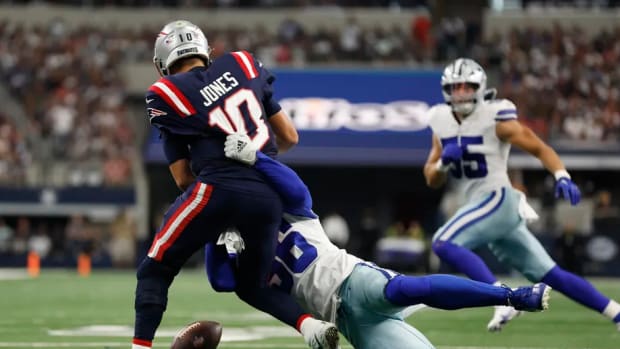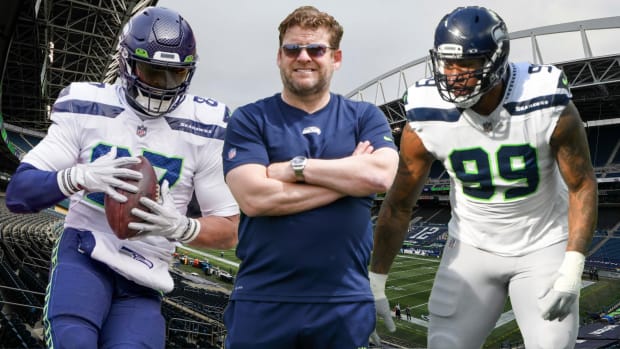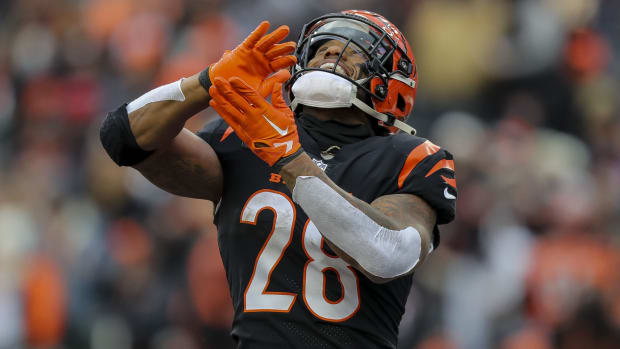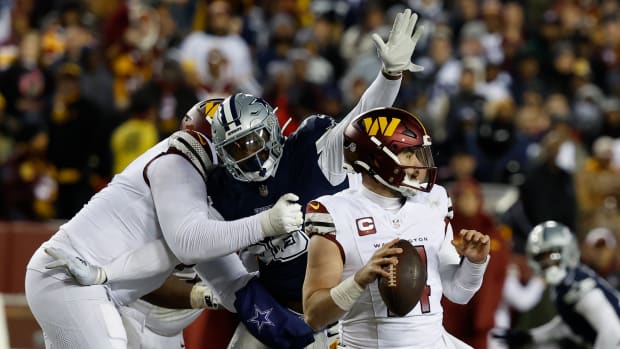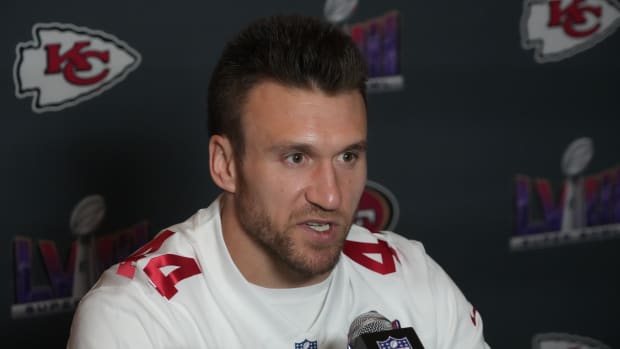Washington Preview: Will a New Coach Mean a New and Improved RG3?
Washington quarterback Robert Griffin III and new coach Jay Gruden. (Nick Wass/AP)
Throughout the preseason Andy Benoit will provide in-depth breakdowns of all 32 teams, in reverse order of 2013 finish. Today, Washington …
OFFENSE
What’s real: the Washington team that went 10-6 and won the NFC East two years ago, or the one that went 3-13 last year and earned the No. 2 overall pick in the draft (albeit for St. Louis)? The answer comes down to how you interpret Robert Griffin III.
But either way, this won’t be “the same” Washington team that we’ve seen in either of the past two seasons. Coach Mike Shanahan and his zone-centric scheme are out; Jay Gruden and his balanced, multifaceted system are in. Of the seven head coaching changes in 2014, this is the most intriguing. The up-and-coming Gruden has a sharp offensive mind and, just like his older brother Jon, an out-sized personality.
How Griffin develops in Year One under Gruden will provide the strongest indication yet of what kind of quarterback the talented but somewhat enigmatic 24-year-old can be. Griffin’s slow recovery from a January 2013 knee injury may have been a blessing in disguise, as it brutally exposed a major weakness last season that he needs to correct: a lack of pocket poise.
There’s never been a truly great NFL QB who couldn’t operate from the pocket. Griffin’s comfort here is close to nonexistent.
There’s never been a truly great NFL quarterback who couldn’t operate from the pocket. Griffin’s comfort here is close to nonexistent. His drop-back mechanics sometimes disappear; his sense of timing and spacing seem to be almost randomized; he’s yet to show consistent plant-and-throw proficiency. All of this contributes to his being a one-read progression passer—something that no truly great NFL quarterback has ever been.
If he’s fully healthy, Griffin’s weaknesses are not quite periling because of his ability to take off and run. On top of creating big plays, Griffin’s legs—the mere threat of his legs, in fact—can force defenses to simplify. Still, the running alone won’t sustain Griffin and Washington’s offense in the long haul.
While Gruden has said he won’t make Griffin “a robot,” there will undoubtedly be less pistol and read-option. There will also be presumably fewer rollout run-pass option plays to reduce the risk of injury. To do his part, Griffin must learn to get rid of the ball; far too many of his hits are self-inflicted wounds stemming from an inability to identify receivers quickly enough.
DeSean Jackson (Evan Vucci/AP)
Gruden was very diverse with his passing designs as the Bengals’ offensive coordinator. He benefitted from good weapons in Cincinnati and, unlike the previous Washington regime, he’ll benefit from good receiving weapons here. That change starts with DeSean Jackson, who signed for three years and $24 million ($16 million guaranteed) after a highly publicized release from Philadelphia this past offseason.
Jackson gives this receiving corps top-flight speed and the home run potential it’s been sorely lacking. That said, he’s not a true No. 1 receiver. He struggles to get off jams and away from tight man coverage, which is why he sometimes disappears when facing elite cornerbacks (as he did against the Cardinals’ Patrick Peterson last year). Gruden will have to help Jackson by using him off pre-snap motion, out of tight-split alignments, in trips bunch formations and with switch-release routes. All of these ploys can give Jackson initial space off the line of scrimmage, allowing him to get deep into a secondary quicker, which influences safeties and helps define the coverage for Griffin.
Jackson isn’t Washington’s only weapon in the passing game. Pierre Garcon makes for a superb second option, thanks to his strength and physicality in short areas and running after the catch. The pistol-heavy system didn’t always allow for it last year, but Garcon can also be potent at the deep-intermediate levels, just as he was playing opposite Reggie Wayne in Indianapolis.
Filling out the rest of the receiving corps: Andre Roberts is potentially the viable slot specialist that’s long been missing; Aldrick Robinson has shown improvement as a downfield route runner outside; Santana Moss isn’t what he once was, but his awareness is very good; and fifth-round rookie Ryan Grant figures to get opportunities, which likely means Leonard Hankerson, coming off a knee injury, will be wedged out.
And then there’s Jordan Reed. If concussions are no longer a problem for him, he can be a top five tight end by the end of December. The supple 2013 third-round pick has good enough hands and an understanding of how to win against man coverage (he’ll often face overmatched safeties and linebackers). Best of all, he has the versatility to line up anywhere. Expect him to appear not just in the slot and split wide, but also in the backfield, as Aaron Hernandez did for the Patriots in 2012.
In Cincinnati, Gruden used two tight ends (Jermaine Gresham and Tyler Eifert) like this. In Washington, he can build around only Reed. Niles Paul has the skillset to be versatile but scares no one; Logan Paulsen is more of a blocker.
Paulsen’s playing time will depend on whether coaches want him or fullback Darrel Young chaperoning for tailback Alfred Morris. As his 2,888 rushing yards in two seasons attest, Morris is an excellent downhill runner. His forte is reaching the perimeter behind zone-blocking. It will be interesting to see how he performs if Gruden chooses to bedash the running game with more man-blocking concepts.
Whatever the blocking structure, Trent Williams needs to be at its forefront. Entering his fifth season, Williams has lived up to his billing as the fourth overall pick from 2010. Though he plays left tackle, he’s actually a steadier run-blocker than a pass protector.
Left tackle is Washington’s only proven and secured O-line position, but that doesn’t mean the other spots can’t be aptly filled. Kory Lichtensteiger, who had great chemistry with Williams in the ground game at left guard, was moved to center to replace the departed Will Montgomery and give third-year pro Josh LeRibeus a crack at starting. This was actually supposed to happen a year ago, but LeRibeus wasn’t in shape. To hedge against a possible recurrence, GM Bruce Allen signed ex-Brown Shawn Lauvao to a four-year, $17 million deal and spent a third-round pick on Spencer Long, who figures to eventually push for right guard Chris Chester’s job. At right tackle, it’s only a matter of time before Tyler Polumbus gets relegated to second string. Twelve picks before taking Long, Allen selected Virginia’s Morgan Moses, whom many draft pundits projected as a long-term starter.
The front line’s performance takes on added significance when you consider that Griffin will almost certainly have some growing pains as he tries to become more of a progression pocket passer. Whether he gets the blocking to allow for much-needed breathing room could be the deciding factor as to whether this team gets back to double-digit wins.
DeAngelo Hall stealing the ball and making a one-handed interception last October. (Justin Edmonds/Getty Images)
DEFENSE
It’s rare to see a man who coordinated the league’s 18th and 28th ranked defenses in each of the last two years keep his job after a head coaching change. But Jim Haslett and Gruden have a strong relationship, having worked together in 2009 for the United Football League’s Florida Tuskers.
Jay Gruden sharply recognized that Haslett, whom he worked with on the UFL Florida Tuskers, deserved to stay. Despite what the statistics say, the 26-year veteran coach has done a stellar job in Washington. Hamstrung by ineptitude at safety, he’s had to diversify and exaggerate his already thick defensive playbook. Almost every week, you’ll see his unit make regular use of eight-man coverages, all-out blitzes and everything in between. You’ll often even see this during the same series.
Haslett will have to keep playing this way in 2014. Washington signed longtime Steeler Ryan Clark to bring some veteran awareness to its defensive backfield, but if Clark could still regularly perform at a high level, he’d still be in Pittsburgh. Missed tackles and downfield coverage have become a problem for the 34-year-old. Washington also re-signed Brandon Meriweather, a rangy pass-defender and gruesome hitter. The good news is Meriweather shows almost no rust every time he returns from a lengthy absence; the bad news is there have been far too many absences because of injuries.
Washington signed longtime Steeler Ryan Clark to bring some veteran awareness to its defensive backfield, but if Clark could still regularly perform at a high level, he’d still be in Pittsburgh.
Last year’s fourth-round pick Phillip Thomas is looking for his first NFL action after suffering a Lisfranc injury in Week 1 of the 2013 preseason.
E.J. Biggers actually found himself at nickel safety last season out of necessity. He was decent there, but the hope is that he can return to his regular outside nickel corner duties—though he’ll have to beat out free agent pickup Tracy Porter, who has always been somewhat of a hit-or-miss big-play seeker.
Porter in this sense is nothing compared to DeAngelo Hall. Though Hall hasn’t quite turned into the second coming of Charles Woodson, he’s still Haslett’s most versatile player in the secondary. Several times last season he successfully shadowed the opponent’s top receiver. That, however, may have been more about No. 2 corner David Amerson, a 2013 second-round pick who struggled in a starter’s role. Amerson at least rebounded well enough down the stretch to warrant a crack at retaining his job this season.
The best remedy for a tenuous secondary is a good pass rush. Haslett has often had to manufacture one through blitz designs. But with Brian Orakpo, Ryan Kerrigan and rookie Trent Murphy in the mix, he can rely more on a straight four-man rush if he so chooses. Orakpo is a good power player; Kerrigan has great hands and a newfound sense for edge moves; Murphy warranted the 47th overall pick.
Orakpo and Kerrigan are both proficient against the run, which is important following the retirement of London Fletcher. But there are questions at inside linebacker. Perry Riley has improved steadily since cracking the starting lineup in 2011, but can he lead? And, in Fletcher’s old spot, can Keenan Robinson even play? If the coaching staff and front office were sure he could, they wouldn’t have signed free agents Darryl Sharpton and Akeem Jordan.
To take pressure off the inside linebackers, Washington also signed a much pricier free agent, Jason Hatcher (four years, $27.5 million, $10.5 guaranteed), who figures to bring more penetration to what was already a strong front line. Hatcher will likely replace former Cowboys teammate Stephen Bowen, who is coming off microfracture surgery. Bowen might still get reps in a rotation with the energetic Kedric Golston and fourth-year pro Jarvis Jenkins. Anchoring the line between these ends is Barry Cofield, one of the most playmaking-oriented nosetackles in the league.
SPECIAL TEAMS
By drafting seventh-round kicker Zach Hocker, management said they’re not completely sold on Kai Forbath. They also weren’t sold on punter Sav Rocca, who was cut in March. Robert Malone and Blake Clingan will compete for the open job. In the return game, Washington has long had several experienced but just so-so options; Andre Roberts wants to change that.
BOTTOM LINE
If Griffin takes a big step forward mentally, physically and fundamentally, Washington can compete for an NFC East title. Most likely, though, it will take him at least a full year to enter the realm of being a proficient drop-back passer.





































